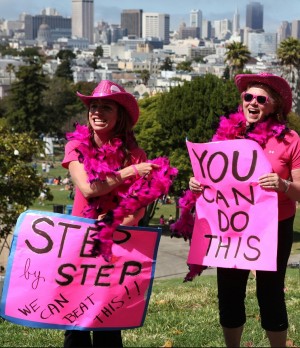‘Pink Ribbon, Inc.’: The Tyranny of Pink
Whatever you think about the color pink, it’s probably pretty harmless. From baby girl shower blankets to that sweet-sixteen wallpaper you picked out for her, it’s bound to please. And for those intrepid film buffs out there, there’s everything from The Pink Panther comedies to the delectability of Kay Thompson’s fashion editor in Funny Face, exhorting us in song to “Think Pink.” But, guaranteed, when you see Pink Ribbons, Inc., Lea Pool’s new documentary on the politics of breast cancer philanthropy, you’ll never think about pink the same way again.
The Party and the Participants
When Ravida Din, the National Film Board of Canada’s executive producer and Nancy Guerin, the associate producer and writer of the film, decided to undertake breast cancer and cause marketing as their subject, they knew it would be like a pink elephant in the room. Breast cancer had become the favorite poster child of megalithic corporate marketing campaigns.
One of the few men given airtime, Marc Hurlbert, the executive director of the global breast cancer programs for Avon Foundation for Women and the Avon Breast Cancer Crusade, with programs in more than 55 countries, is an example of this marketing trend. Another heavy-hitting presence in the movement, if not the film, is Evelyn H. Lauder, the Senior Corporate Vice President of the Estee Lauder Companies and the founder of the Breast Cancer Research Foundation. Theirs was the first company to use the pink ribbon as the iconic symbol for awareness and credited from the outset with its popularity.
Out of four major breast cancer fundraising organizations in North America, the Susan G. Komen for the Cure is undeniably the largest, having raised over a billion dollars. If you’re going to invite the biggest players to the party, you’d better do your research — four years of R&D and a year of interviews and filming — and you’d better have the best party planner you can find. For Din, that was award-winning director Lea Pool. “I knew Lea’s strength would be to bring a cinematic approach,” she said in a press interview for the film’s distributor, “and make what might have been a talking-head-kind of film accessible to a large audience. It had to be both emotional and intellectual.”
Is it emotional? Undoubtedly; only the hardest-hearted among us would not be moved by the confessions of the IV League, a small support group of Austin-based women living with Stage IV metastatic breast cancer. Or there’s the image of a heavy-set African-American woman trudging up a steep hill during the two-day Avon Walk for Breast Cancer in San Francisco, and step by step, falling behind her more robust sisters. The camera holds for that crucial additional second or two, and lets us experience the isolation.
Is it intellectual? You’d better have paper and pen at hand because the rollout of statistics alone is numbing: Over 59,000 women die from the disease in North America every year. In the 1940s, one out of every 22 women were at risk; in 2011 the figures jumped to one out of every eight. But that’s statistics. After awhile, they lose their power to impress. To pump up her argument, Pool gives us enough “talking-heads” with resumes to match to give pause to any potential detractors.
The sheer number of interviews is dizzying. In Pool’s words, she didn’t want her point of view to pull the direction of the film. “Of course it does,” she admits, “because I edited it, but I wanted everyone to be able to say what they had to say.” She wanted above all to be “respectful.” That’s unfortunate. Because in trying to achieve the perfect balance between the courage of the Pink Ribbon’s legions of participants and the businesses that use these events to blatantly promote their products for profit, she’s over-weighted the scales. “Less is more” is an old adage that never goes out of style and in the hands of this multifaceted director, a smaller cast with longer exposure time would have been worth the risk. As it stands, it’s as if she were afraid that the audience would go screaming from the room if every sober second wasn’t offset with a shrill cacophony of celebrants, dancing and prancing their way down the pink brick road to meet the wizard to cure-all-ills. That’s timid for this filmmaker, because as she says while shooting the Revlon Walk in New York, “I didn’t once see the word ‘cancer.’ They don’t even want to show that it’s cancer — it’s all erased so that everything is set up to give a feeling of hope. It’s a false image.”
One smart choice she made was to eliminate narration. This is an important factor as it keeps the viewer focused on the individual contributor, brief as that might be, rather than listening to an unseen, glossy “voice of God” guiding us through the labyrinth of facts and suppositions.
A sampling of the players from Pool’s prodigious list includes Barbara Ehrenreich, the widely read columnist and author of nearly 20 books, including the bestseller Nickel and Dimed. Her report, Welcome to Cancerland, was a springboard for producer Din’s decision to proceed with the project. When Ehrenreich was diagnosed with breast cancer in 2001, she didn’t research the science of the disease; she felt like an anthropologist trying to understand what was going on. “What’s with these pink ribbons and everything?” Later, perusing a local paper while waiting for a mammogram result, she found an ad promoting breast cancer awareness for a pink teddy bear. It deeply offended her sense of dignity as a middle-aged woman. “I’m sorry,” she confessed. “I’m not six-years-old.”
(Article continued on next page)

